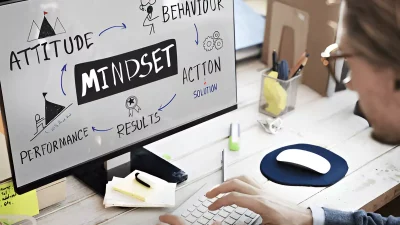The digital realm isn’t a fad, it’s the wellspring from which we create art, work, invent and communicate. In the current era, jumping into the digital realm isn’t a nice-to-have but a must-have. A digital mindset can help individuals and organizations uncover innovation, enhance processes and expand opportunities for growth.
But just what is a digital mindset? So why should you have one, and how can you make one? This article is to break it down for you and give you some actionable insights to take and and own this new digital 1st life that we are now living and working in.
What is a Digital Mindset?
And at heart, a digital mindset is about accepting that technology has an important role to play in driving change and enhancing things; it is about reimagining processes and solving problems.
It’s not only about being tech-savvy or simply being skilled with digital tools, though those are parts of it. It is, instead, about recognizing the opportunities in the transition from traditional ways of doing things to digital ways, and embracing innovation.
A digital person “sees” the use of technology to make the day-to-day easier, make more informed decisions, and drive greater value. It’s this emphasis on efficiency, adaptability and lifelong learning that characterizes the digital-first mindset.
Why a Digital Mindset Matters
In an age of digital transformation affecting almost every industry, embracing a digital mindset is something more than just tech professionals can strive for.
Here’s why it’s vital for everyone from employees and C-suite executives to freelancers:
-
Competitive Edge: Companies that embrace digital thinking are six times more likely to outperform their peers, McKinsey & Co.
-
Flexibility: Technology is changing faster than publishers and platforms can pivot to keep up. Those who have a digital mindset have the ability to adapt to these changes more easily.
-
Inform Businesses: Data is digital gold. Knowing how to work with technology to get data-driven insights leads to making more informed decisions.
-
Increased Collaboration: As the workforce continues to be more mobile and cloud software tools become more integrated, a digital frame of mind can help bolster communication and overall productivity across multiple locations.
Whether you’re leading a team, operating a company, or working on a personal brand, preparing yourself with a digital mindset will keep you at the cutting edge.
7 Tips to Foster a Digital Mindset
This might sound vague, but learning to have a digital mindset is something everyone can do. Create a tech-forward, innovation-ready mindset by following these actionable steps.
1. Shift Your Perspective
First and foremost, it is necessary not to see digital tools as something alien or scary. Start by questioning how technology can make everyday tasks easier or more pleasurable.
-
‘Can that laborious manual process be automated?’
-
Could data analytics help bring clarity to that vexing issue?
The key here is curiosity. Instead, take technology with an explorer’s disposition, not a screener’s one, realizing what it is: a toolkit for solving modern problems.
2. Develop Your Digital Literacy
The first step is digital literacy. It doesn’t require being a coding wizard; it’s about understanding the basics of digital tools as well as data and trends in your chosen field.
Here are the small steps you can take to form this knowledge:
-
Check out online technology training courses on sites like Coursera or LinkedIn Learning.
-
Follow tech and innovation thought leaders to get the latest.
-
Play with tools such as Trello for project management, Zapier for pretty basic automation, or Tableau for data viz.
The more familiar you become, the more confident you’ll feel.
3. Get Comfortable with Change
Digital is always changing, and digital thinkers understand how to be flexible in a state of flux. Adopt the expectation that learning is ongoing and that being “done” with change is not possible.
For instance, AI-based tools like ChatGPT have revolutionized the way people work with writing, customer support, or operations. It can be scary at first to use new tools like these, but the payoff is tremendous.
Tip: Start small. Concentrate on picking up one tool, or adding a new digital habit to your daily/weekly/monthly routine each month.
4. Make Decisions Based on Data
Data is the currency of the digital universe. In order to really embrace digital thinking, you must be versed in the mechanics of collecting, analyzing and using data to act smartly.
Ask yourself:
- How can I monitor success in my role (or business)?
- How can I plug into analytics tools to learn things that I didn’t know?
- How do I mix and match quantitative data with qualitative understanding to make a more rounded decision?
Platforms such as Google Analytics, Excel, or business intelligence tools are good starting points, even for beginners.
5. Focus on Collaboration Tools
The ability to learn and adapt to new collaboration technologies is essential to staying digitally connected in today’s work environment.
Whether that means using:
-
Slack channels for communicating
-
Asana for tracking projects
-
Zoom for video meetings
Playing around with digital collaboration tools can help teams avoid redundancy.
And more than that, they build a culture of openness and responsibility. That sets the stage for a more connected, functional workplace, whether your team works remotely, in person, or in some hybrid of the two.
6. Hang in There When You Hit Obstacles
If you’re adapting to the digital world, you will encounter failures.
-
Perhaps your organization just installed a new CRM that’s complex.
-
Perhaps the automations you’ve tested out seem clunky or ineffective at the outset.
The point is to change your state of mind from frustrating to experimenting.
Keep in mind that, like anything digital, most tools are better with practice, customization and feedback. Keep your eyes on the long-term gains they offer, and consider each letdown as a step on the learning curve.
7. Develop a Learning Culture
The digital mindset isn’t something you unlock and then leave gathering dust in the corner; that shit needs feeding. Keep curious and open to learning about new trends, tools and ways of working.
How to build this culture is:
- Join tech webinars and workshops.
- Sign up to tech-based podcasts or newsletters (like The Verge or Wired).
- Participating in online communities or forums where the future of your sector is being discussed.
When you keep learning, you stay ahead and ready to tackle new challenges.
The Future Is Not Technology; The Future Is Now
The future is no longer digital; it’s here, and it’s shaping the way we live, work, and connect with one another.
This new way of thinking isn’t just a matter of survival in a shifting digital world, it’s about thriving in it.
Open yourself to change, learn new tools, and use data-driven insights to shape possibilities for personal growth and success.
If you want something more comprehensive to build your digital skills, check out our free resources or register for our webinars, where we delve into these strategies in more detail.
Just remember that the first step toward growth is to be curious.



